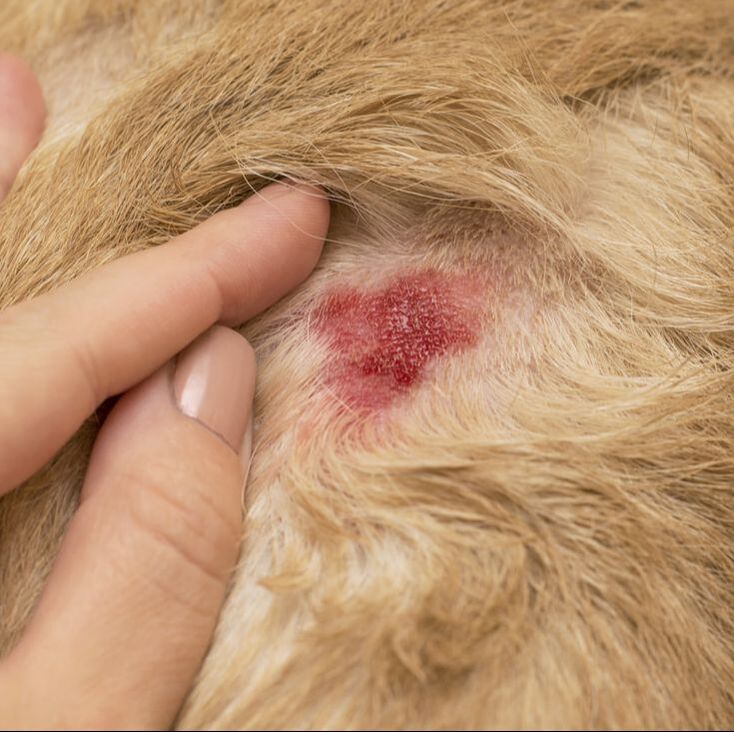Hot spots are patches of inflammation, infection and irritated skin that can be found anywhere on your dog. They often appear wet and slimy, red, and may or may not have scabs surrounding the area. Hot spots only get worse when left untreated, and can develop into larger patches of infection on your dog's body.
How to Treat your Dog's Hot Spots at Home
| The good news is that although they can be slow to heal, it is easy to treat hot spots right at home. It is important to catch them early and help them clear up before they grow into a more serious infection. Hot spots are especially common on dogs that get wet often, or live in a climate with a lot of rain or humidity. Treating a hot spot at home includes cleaning the area gently but thoroughly, drying it carefully, applying a soothing treatment, and preventing your dog from touching that spot while it heals. The steps you take should be repeated daily. There are several options for all of these steps, so lets go over them! |
This should be done gently and carefully, because hot spots can be extremely itchy and/or painful for your dog. There are multiple solutions you can use to clean the hot spot. You only need to choose one of the following options!
- Give your dog a bath with a gentle dog safe shampoo.
- Dab and gently wipe with a 50/50 solution of Hydrogen Peroxide and lukewarm water. (This should only be done once.)
- Dab and gently wipe with a solution of animal safe Betadine (antiseptic) and lukewarm water.
- Dab and gently wipe with lukewarm water and a bit of dawn dish soap.
DRY THE AREA
There are several methods of drying the area you can safely use to prepare the hot spot for treatment.
- Use a soft, dry, clean cloth or towel to press and dab the moisture away from the skin.
- Use a blow dryer on the low and cool settings, moving it around the area and keeping it farther away from the skin.
- Pat it dry, then allow it to completely air dry.
APPLY TREATMENT TO THE HOT SPOT
Once the hot spot has been cleaned and dried, you'll want to apply a soothing treatment to the area to allow it to heal. Once again, you have several options for things you can apply to the area! Simply use a cotton swab, a clean towel or a clean finger to gently dab the solution all over the hot spot.
- Organic, extra virgin, unrefined coconut oil.
- A thin layer of Polysporin.
- Tea bag compresses (black or green tea). Only use when cool or lukewarm.
- Pure Aloe Vera gel.
- Manuka Honey
- Colloidal Silver
KEEP YOUR DOG AWAY FROM IT
The last step is extremely important. You'll need to make absolutely certain that your dog does not lick, chew, scratch or rub the hot spot anymore. All it takes is one minute of your dog interacting with the spot for all of your progress to be undone, and for the hot spot to get worse. Here are some ways you can keep your dog away from the healing hot spot.
- Put a cone (also called an Elizabethan collar) on your dog.
- Put a t-shirt, sock or piece of clothing on your dog that covers the hot spot completely. Make sure the hot spot can still "breathe", so no tight materials.
- Monitor your dog to prevent them from bothering the hot spot when it is not covered or kept out of their reach.
- Distract your dog with healthy things to chew on, like raw bones.
It is important to monitor the hot spot daily. If treatment fails, they can get out of control and fester into a more serious infection. If the hot spot gets worse despite your home treatment, you will need to have it seen by your Veterinarian. Any very large hot spots, or if multiple hot spots are present, likely have an underlying cause that needs to be addressed by a veterinarian.
Home treatment can be repeated daily!
For more amazing information on natural dog health care (supported by scientific research), feel free to come join my exclusive closed Facebook group: K9 Instinct: Holistic Dog Health Care. In that group I share all of my new articles and any new research or news in the pet world.





 RSS Feed
RSS Feed
